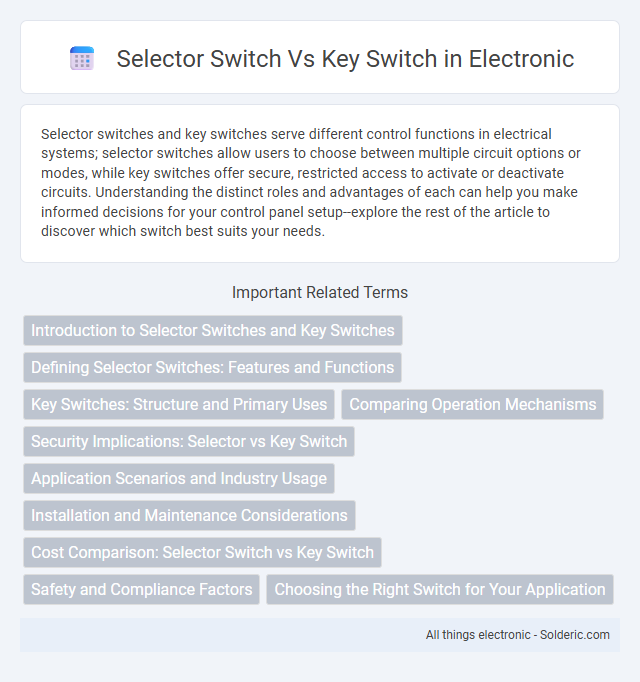Selector switches and key switches serve different control functions in electrical systems; selector switches allow users to choose between multiple circuit options or modes, while key switches offer secure, restricted access to activate or deactivate circuits. Understanding the distinct roles and advantages of each can help you make informed decisions for your control panel setup--explore the rest of the article to discover which switch best suits your needs.
Comparison Table
| Feature | Selector Switch | Key Switch |
|---|---|---|
| Function | Allows selection between multiple electrical circuits or modes | Requires a physical key to activate or deactivate a circuit |
| Security | Low to moderate, no key required | High, key needed to operate |
| Usage | Common in industrial control panels and machinery | Used where controlled access is necessary |
| Operation | Rotary or toggle action to select options | Key insertion and turning required |
| Applications | Mode selection, power switching, equipment control | Security locks, safety shutdown, restricted access control |
| Cost | Generally lower cost | Higher cost due to key mechanism |
Introduction to Selector Switches and Key Switches
Selector switches offer multiple positions that allow you to control electrical circuits with ease, commonly used in industrial control panels for mode selection or operational settings. Key switches provide enhanced security by requiring a physical key to operate, ensuring authorized access and preventing unauthorized use of machinery or systems. Both switches serve distinct purposes in control and security applications, making them essential components in various electrical setups.
Defining Selector Switches: Features and Functions
Selector switches are rotary or toggle devices used to control electrical circuits by selecting different operational modes or functions in machinery and control panels. They feature multiple positions, often labeled, allowing users to make precise adjustments such as switching between start, stop, or various speed settings. Commonly found in industrial automation and control systems, selector switches enhance user interface by providing clear, reliable input options for system configuration.
Key Switches: Structure and Primary Uses
Key switches are mechanical or electronic components designed to open or close electrical circuits through the pressing of a key, commonly found in keyboards, typewriters, and control panels. Their structure typically includes a stem, spring, and housing that ensure tactile feedback and reliable actuation, with variations such as membrane, mechanical, and capacitive switches. Primarily used for input devices, key switches provide precise control and durability essential for computing, telecommunications, and industrial machinery interfaces.
Comparing Operation Mechanisms
Selector switches operate by rotating or toggling a knob to choose between multiple circuit positions, using a mechanical cam or rotary mechanism that changes connection points. Key switches require a specific key to engage or disengage the electrical contacts, ensuring controlled access through a lock-and-turn mechanism. Understanding these operation mechanisms helps you decide which switch type best suits your security and functional needs.
Security Implications: Selector vs Key Switch
Selector switches offer limited security as they can be easily toggled by unauthorized users, making them suitable primarily for basic operational control without stringent access restrictions. Key switches provide enhanced security by requiring a physical key to operate, reducing the risk of unauthorized activation or tampering in sensitive environments. The physical key mechanism in key switches ensures controlled access and accountability, making them ideal for applications where operational security is critical.
Application Scenarios and Industry Usage
Selector switches are widely used in industrial control panels, manufacturing machinery, and automation systems for manual mode selection and operational control due to their simplicity and durability. Key switches find primary application in security-sensitive environments such as access control systems, emergency stop functions, and high-value equipment activation, ensuring authorized user operation. Both switch types serve critical roles in sectors like automotive, aerospace, and heavy machinery, where reliable and secure control inputs are paramount.
Installation and Maintenance Considerations
Selector switches typically offer easier installation due to their modular design and standardized mounting options, reducing setup time and complexity. Key switches require precise alignment and secure locking mechanisms during installation, which may involve more detailed wiring and physical adjustments to ensure proper functionality. Maintenance for selector switches generally involves routine checks for wear and debris, while key switches often demand more frequent inspections to prevent lock cylinder jamming and ensure reliable operation in security-sensitive environments.
Cost Comparison: Selector Switch vs Key Switch
Selector switches typically cost less than key switches due to their simpler design and fewer security features, making them a budget-friendly option for general control panels. Key switches, incorporating locking mechanisms and enhanced tamper resistance, usually come at a higher price point but offer superior security for critical applications. Your choice depends on balancing cost efficiency with the level of access control needed in your specific environment.
Safety and Compliance Factors
Selector switches often provide enhanced safety features such as clear visual positions and detented feedback, ensuring precise control in industrial environments, which aids compliance with OSHA and IEC standards. Key switches offer an added layer of security by restricting unauthorized access through key control, aligning with safety protocols in sensitive applications like access control and emergency shutdown systems. Both switch types must meet relevant UL and CE certification requirements to ensure reliability and adherence to safety regulations in electrical installations.
Choosing the Right Switch for Your Application
Selector switches offer versatile control options with multiple positions, ideal for applications requiring mode selection or system configuration. Key switches provide enhanced security by restricting operation to authorized users, making them suitable for access control in critical equipment. Selecting the right switch depends on balancing control complexity with security needs to optimize functionality and safety in industrial or commercial settings.
selector switch vs key switch Infographic

 solderic.com
solderic.com